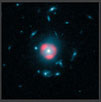McGill Researchers from the CRAQ use ALMA to rewrite the history of Universe’s stellar baby boom
 Observations with the Atacama Large Millimeter/submillimeter Array (ALMA) show that the most vigorous bursts of star birth in the cosmos took place much earlier than previously thought. The results are published in a set of papers to appear in the journal Nature and in the Astrophysical Journal. The research is the most recent example of the discoveries coming from the new international ALMA observatory, which celebrates its inauguration in March 2013.
Observations with the Atacama Large Millimeter/submillimeter Array (ALMA) show that the most vigorous bursts of star birth in the cosmos took place much earlier than previously thought. The results are published in a set of papers to appear in the journal Nature and in the Astrophysical Journal. The research is the most recent example of the discoveries coming from the new international ALMA observatory, which celebrates its inauguration in March 2013.
The most intense bursts of star birth are thought to have occurred in the early Universe, in massive, bright galaxies. These starburst galaxies convert vast reservoirs of cosmic gas and dust into new stars at a furious pace — many hundreds of times faster than in stately spiral galaxies like our own galaxy, the Milky Way. By looking far into space, at galaxies so distant that their light has taken many billions of years to reach us, astronomers can observe this busy period in the Universe’s youth.

The team, composed of researchers from McGill including doctoral candidate Yashar Hezaveh, first author of one of the three articles, and professors Gil Holder and Matt Dobbs, was surprised to find that many of these distant dusty star-forming galaxies are even further away than expected. This means that, on average, their bursts of star birth took place 12 billion years ago, when the Universe was just under 2 billion years old — a full billion years earlier than previously thought.
Two of these galaxies are the most distant of their kind ever seen — so distant that their light began its journey when the Universe was only one billion years old. What’s more, in one of these record-breakers, water is among the molecules detected, marking the most distant observations of water in the cosmos published to date. The team used the unrivalled sensitivity of ALMA, a global collaboration that includes a significant Canadian contribution, to capture light from 26 of these galaxies at wavelengths of around three millimetres. Light at characteristic wavelengths is produced by gas molecules in these galaxies, and the wavelengths are stretched by the expansion of the Universe over the billions of years that it takes the light to reach us. By measuring the stretched wavelengths, astronomers can calculate how long the light’s journey has taken, and place each galaxy at the right point in cosmic history.
They took advantage of a helping hand from nature, too, using gravitational lensing — an effect predicted by Einstein’s general theory of relativity, where light from a distant galaxy is distorted by the gravitational influence of a nearer foreground galaxy, which acts like a lens and makes the distant source appear brighter.
To understand precisely how much this gravitational lensing brightened the view of the galaxies, the team made sharper images of them using more ALMA observations at wavelengths of around 0.9 millimetres.
“These beautiful pictures from ALMA show the background galaxies warped into multiple arcs of light known as Einstein rings, which encircle the foreground galaxies,” said McGill’s Yashar Hezaveh, who led the study of the gravitational lensing. “We are using the massive amount of dark matter surrounding galaxies half-way across the Universe as a cosmic telescope to make even more distant galaxies appear bigger and brighter.”
Analysis of the distortion reveals that some of the distant star-forming galaxies are as bright as 40 trillion (40 million million) Suns, and that gravitational lensing has magnified this by up to 22 times.
With his scholarship from the international internship program of the FRQ-NT and his doctoral scholarship, Yashar joined the international research team and participated in the work published in the prestigious journal Nature and The Astrophysical Journal.
- http://adsabs.harvard.edu/abs/2013arXiv1303.2722H
- http://adsabs.harvard.edu/abs/2013arXiv1303.2723V
- http://adsabs.harvard.edu/abs/2013arXiv1303.2726W
Source :
Chris Chipello
Université McGill, Media Relations Office
Tél. : 514-398-4201
Informations:
Olivier Hernandez, Ph.D.
Relation avec les médias
CRAQ – Université de Montréal
Tel. : 514-343-611,1 poste 4681
olivier@astro.umontreal.ca | @OMM_Officiel | @CRAQ_Officiel
